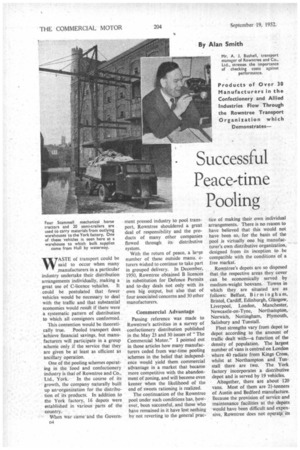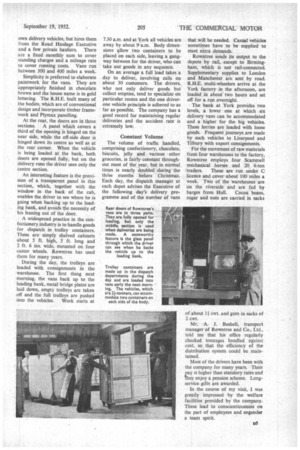Successful Peace-time Pooling
Page 78

Page 79

If you've noticed an error in this article please click here to report it so we can fix it.
WASTE of transport could be said to occur when many manufacturers in a particular industry undertake their distribution arrangements individually, making a
great use of C-licence vehicles. It could be postulated that fewer vehicles would be necessary to deal with the traffic and that substantial economies would result if there were a systematic pattern of distribution to which all consignors conformed.
This contention would be theoreti cally true. Pooled transport does achieve financial savings, but manufacturers will participate in a group scheme only if the service that they are given be at least as efficient as ancillary operation.
One of the pooling schemes operating in the food and confectionery industry is that of Rowntree and Co., Ltd., York. In the course of its growth, the company naturally built up an-organization for the distribu tion of its products. In addition to the •York factory, 16 depots were established in various parts of the country.
When war came and the GovernD4 ment pressed industry to pool transport, Rowntree shouldered a great deal of responsibility and the products of many other companies flowed through its• distributive system.
With the return of peace, a large number of these outside manu_ cturers Wished to continue to take part in grouped delivery. In December, 1950, Rowntree obtained B licences in substitution for Defence Permits and to-day deals not only with its own big output, but also that of four associated concerns and 30 other manufacturers.
Commercial Advantage
Passing reference was made to Rowntree's activities in a survey of confectionery distribution published in the May 23 and 30 issues of "The Commercial Motor." I pointed out in those articles how many manufacturers ceded from war-time pooling schemes in the belief that independence would yield them commercial advantage in a market that became more competitive with the abandonment of zoning, and will become even keener when the likelihood of the end of sweets rationing is realized.
The continuation of the Rowntree pool under such conditions has, however, been successful, and those who have remained in it have lost nothing by not reverting to the general prac
tice of making their own individual arrangements. There is no reason to have believed that this would not have been so, for the basis of the pool is virtually one big manufacturer's own distributive organization, designed from its inception to be compatible with the conditions of a free market.
Rowntree's depots are so disposed that the respective areas they cover can be economically served by medium-weight boxvans. Towns in which they are situated are as follows: Belfast, Bir min gha m, Bristol, Cardiff, Edinburgh, Glasgow, Liverpool, London, Manchester, Newcastle-on-Tyne, Northampton, Norwich, Nottingham, Plymouth, Salisbury and Tunstall.
Fleet strengths vary from depot to depot according to the amount of traffic dealt with—a function of the density of population. The largest number of vans is centred on London where 40 radiate from Kings Cross, whilst at Northampton and Tunstall there are two. The York factory incorporates a distributive depot and is served by 19 vehicles.
Altogether, there are about 120 vans. Most of them are 21-tonners of Austin and Bedford manufacture. Because the provision of service and maintenance facilities at the depots would have been difficult and expensive, Rowntree does not operate its own delivery vehicles, but hires them from the Road Haulage Executive and a few private hauliers. There are a fixed monthly sum to cover standing charges and a mileage rate to cover running costs. Vans run between 300 and 400 miles a week.
Simplicity is preferred to elaborate paintwork for the vans. They are appropriately finished in chocolate brown and the house name is in gold lettering. The R.H.E. built many of the bodies, which are of conventional design and incorporate timber framework and Plymax panelling.
At the rear, the doors are in three sections. A panel which covers a third of the opening is hinged on the near side, while the off-side door is hinged down its centre as well as at the rear corner. When the vehicle is being loaded at the bank, both doors are opened fully, but on the delivery runs the driver uses only the centre section.
An interesting feature is the provision of a transparent panel in this section, which, together with the window in the back of the cab, enables the driver to see where he is going when backing up to the loading bank, and avoids the necessity of his leaning out of the door.
A widespread practice in the confectionery industry is to handle goods for dispatch in trolley containers. These are simply shelved cabinets about 5 ft. high, 5 ft. long and 2 ft. 6 ins, wide, mounted on four castor wheels. Rowntree has used them for many years.
During the day, the trolleys are loaded with consignments in the warehouse. The first thing next morning, the vans back up to the loading bank, metal bridge plates are laid down, empty trolleys are taken off and the full trolleys are pushed into the vehicles. Work starts at 7.30 a.m. and at York all vehicles are away by about 9*a.m. Body dimensions 41low two containers to be placed on each side, leaving a gangway between for the driver, who can take out goods in any sequence.
On an average a full load takes a day to deliver, involving calls on about 30 customers. The drivers,. who not only deliver goods but collect empties, tend to specialize on particular routes and the one driverone vehicle principle is adhered to as far as possible. The company has a good record for maintaining regular deliveries and • the accident rate is extremely low.
Constant Volume The volume of traffic handled, comprising confectionery, chocolate, biscuits, jelly and various other groceries, is fairly constant throughout most of the year, but in normal times is nearly doubled during the thFee months before Christmas. Each day, the dispatch manager at each depot advises the Executive of the following day's delivery programme and of the number of vans that will be needed. Casual vehicles sometimes have to be supplied to meet extra demands.
Rowntree sends its output to the depots by rail, except to Birmingham, which is not rail-connected. Supplementary supplies to London and Manchester are sent by road. R.H.E. multi-wheelers arrive at the York factory in the afternoon, are loaded in about two hours and set off for a run overnight.
The bank at York provides two levels, a lower one at which six delivery vans can be accommodated and a higher for the big vehicles. These lorries are loaded with loose goods. Frequent journeys are made by such vehicles to Liverpool and Tilbury with export consignments.
For the movement of raw materials from four warehouses to the factory, Rowntree employs four Scammell mechanical horses and 20. 6-ton trailers. These are run under C licence and cover about 100 mites a week. Two of the warehouses are on the riverside and are fed by barges from Hull. Cocoa beans, sugar and nuts are carried in sacks of about H cwt. and gum in sacks of 2 cwt.
Mr. A. J. Bushell, transport manager of Rowntree and Co., Ltd., told me that his office regularly checked tonnages handled against cost, so that the efficiency of the distribution system could be maintained.
Most of the drivers have been with the company for many years. Their pay is higher than statutory rates and They enjoy a pension scheme. Longservice gifts are awarded.
In the course of my visit, I was greatly impressed by the welfare facilities provided by the company. These lead to conscientiousness on the part of employees and engender a team spirit.




































































































































































